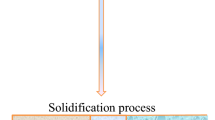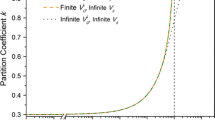Abstract
A one-dimensional mathematical model for a process of solidification of a binary alloy in the presence of an electric field is studied. A situation in which the thermal properties of each phase are different and the latent heat is non-zero is considered. A quasi-static approximation for the thermal and electric fields is used. Local existence and uniqueness of a classical solution to the resulting free boundary problem are proved for two kinds of boundary conditions. Moreover, under particular hypotheses, the monotonicity of the free boundary and the global existence of the solution is proved.
Sommario
Si studia un modello matematico unidimensionale per un processo di solidificazione di una lega binaria in presenza di un campo elettrico. Si considera una situazione in cui le proprietà termiche di ogni fase sono differenti e il calore latente è non nullo. Si usa una approssimazione quasi-statica per i campi elettrico e termico. Si dimostra l'esistenza locale e l'unicità di una soluzione classica per il problema di frontiera libera risultante con due tipi di condizioni di bordo. Inoltre si dimostra, sotto particolari ipotesi, la monotonia della frontiera libera e l'esistenza di soluzione globale.
Similar content being viewed by others
References
Bermudez, A. and Saguez, C., ‘Mathematical formulation and numerical solution of an alloy solidification problem’, in Free Boundary Problems: Theory and Applications, Vol. I, Research Notes in Maths. 78 (1983), 237–247.
Chalmers, B., Principles of Solidification, Krieger, 1977.
Comparini E., ‘On a class of nonlinear free boundary problems’, Boll. Un. Mat. Ital. Suppl. Fis. Mat. 2 (1983), 187–202.
Crowley A. B. and Ockendon J. R., ‘On the numerical solution of an alloy solidification problem’, Int. J. Heat Mass Transfer 22 (1979), 941–947.
Fasano A., ‘Alcune osservazioni su una classe di problemi a contorno libero per l'equazione del calore’, Matematiche (Catania) 29 (1974), 397–411.
Fasano A. and Primicerio M., ‘General free-boundary problems for the heat equation, I’, J. Math. Anal. Appl. 57 (1977), 694–723.
Fasano A. and Primicerio M., ‘Free boundary problems for nonlinear parabolic equations with nonlinear free boundary conditions’, J. Math. Anal. Appl. 72 (1979), 247–273.
Huebener R. P., ‘Thermoelectricity in metals and alloys’, Solid State Phys. 27 (1972), 63–134.
Jastrzebki L., Lagowski J., Gatos H. C. and Witt A. F., ‘Liquid-phase electroepitaxy: Growth kinetics’, J. Appl. Phys. 49 (12) (1978), 5909–5919.
Lagowski J., Jastrzebki L. and Gatos H. C., ‘Liquid-phase electroepitaxy: Dopant segregation’, J. Appl. Phys. 51 (1) (1980), 364–372.
Okamoto A., Lagowski J. and Gatos H. C., ‘Enhancement of interface stability in the liquid phase electroepitaxy’, J. Appl. Phys. 53 (3) (1982), 1706–1713.
Rubinstein, L. I., ‘The Stefan problem’, Amer. Math. Soc. Transl. Math. Mon. 27 (1971).
Tsubaki T., Boley B. A., ‘One-dimensional solidification of binary mixtures’, Mech. Res. Comm. 42 (2) (1977), 115–122.
Wheeler, A. A., Coriell, S. R., McFadden, G. B. and Hurle, D. T. J., ‘The effect of an electric field on the morphological instability: a basic model’ (to appear).
Author information
Authors and Affiliations
Rights and permissions
About this article
Cite this article
Stampella, M. A mathematical model for an alloy solidification problem in the presence of an electric field. Meccanica 26, 211–219 (1992). https://doi.org/10.1007/BF00430938
Received:
Accepted:
Issue Date:
DOI: https://doi.org/10.1007/BF00430938




